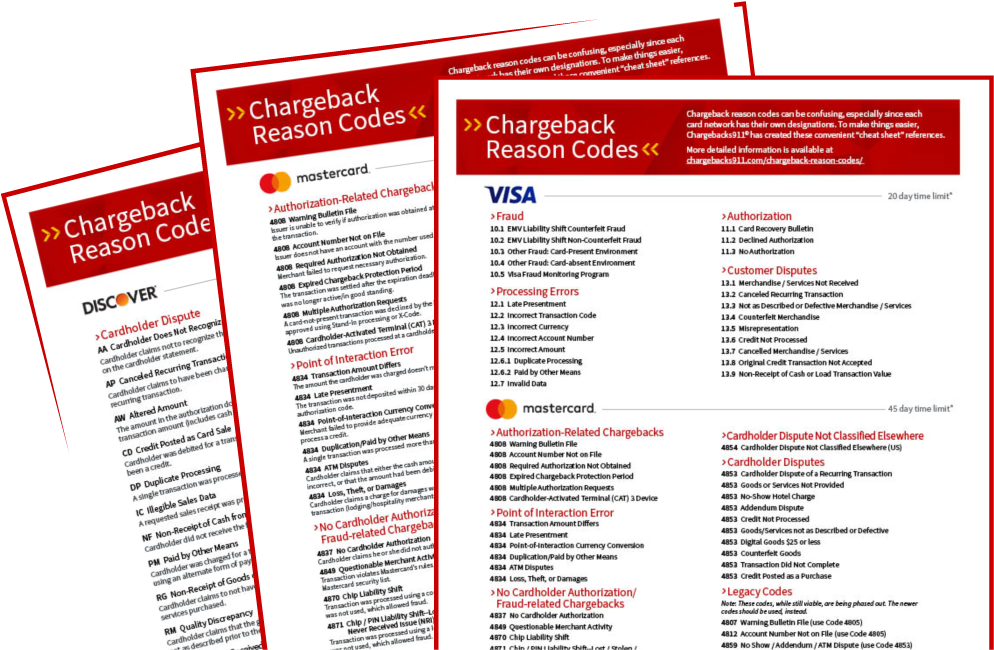Visa Reason Code 10.2: EMV Liability Shift Non-Counterfeit Fraud
For the sake of simplicity and standardization, card networks like Visa have created a breakdown of the acceptable causes for a customer to dispute a credit card charge by filing a chargeback. Each of these causes has a designated “reason code,” and banks assign the appropriate code to each case to show the given reason for the chargeback.
That sounds simple enough, but the reality is, the given reason for a chargeback may or may not be the true reason. Plus, each card network has its own set of reason codes—which, while nearly the same in function, nevertheless differ from one another. Keeping track of all these codes, along with the best ways to either fight or prevent each one, is challenging.
With that in mind, let’s take a look at Visa Reason Code 10.2: EMV Liability Shift Non-Counterfeit Fraud.
Reason Code 10.2 Chargebacks Are Preventable.
Put our knowledge to work for you. Click to learn more.

What is Visa Reason Code 10.2?
Chargeback reason code 10.2 is an updated version of legacy Visa reason code 81, which was phased out under the Visa Claims Resolution initiative. This code applies when a cardholder claims a charge was unauthorized, and the issuer determined that ALL of the following conditions were met:
- The transaction took place in a card-present environment.
- The transaction took place using a card reported stolen, lost, or not received when issued.
- The transaction qualifies for the EMV liability shift.
- The card is a PIN-preferring chip card.
In addition to the above conditions, ONE of the following circumstances must also apply:
- The merchant did not use a chip-reading device to process the transaction.
- The merchant processed a chip-initiated transaction using a chip-reading device that was not EMV PIN-compliant.
- The transaction was chip-initiated but was authorized online without an online PIN, and the processor’s authorization request did not include complete chip data.
Essentially, non-counterfeit fraud chargebacks occur when a client claims that a lost or stolen card has been used in an unauthorized transaction. The EMV liability shift indicates the transaction was processed using outdated equipment...meaning the merchant must accept responsibility for accepting the unauthorized transaction.
Merchant Errors, Rights & Limitations
Chargebacks of any kind are nothing but trouble for merchants. That said, many chargebacks are the direct result of preventable merchant missteps. It’s crucial for businesses to recognize why the merchant is often held responsible for Visa chargeback reason code 10.2 chargebacks:
- The merchant used a non-EMV terminal to process PIN-preferring cards
- The merchant used an EMV terminal which is not PIN-compliant
Most non-counterfeit fraud chargebacks are the result of equipment that has not been updated to match Visa recommendations. But, as mentioned earlier, the given reason for a chargeback may be far different from the actual reason. A cardholder who knowingly tries to file a chargeback under false pretenses commits friendly fraud.
While banks try to investigate all claims thoroughly before processing a dispute, the meteoric rise in chargeback cases has made this extremely difficult. In many cases, it’s more efficient to simply take the customer’s claim at face value. This means the blame is attributed to the merchant, even in cases of friendly fraud.
Again, however, it’s the merchant who is held responsible for chargebacks with a non-counterfeit fraud reason code. This is Visa’s incentive for merchants to update to recommended terminal technology. The issuer’s main limitation here is the timeframe: for Visa chargeback reason code 10.2, the issuing bank has a maximum of 120 calendar days from the transaction processing date chart to dispute a claim.
Preventing & Disputing Chargeback Reason Code 10.2 Claims
No matter how faithfully merchants follow the rules, there will always be people who attempt to take advantage of the system. That said, this specific type of chargeback is largely preventable with simple merchant actions:
- Upgrade to EMV PIN-compliant terminals. This is the fastest and surest way to prevent 10.2 chargebacks.
- Always obtain the appropriate Cardholder Verification Method (CVM) input, such as signature or PIN.
- Take an imprint (either electronic or manual) for every card-present transaction.
While preventative measures can significantly lower the overall volume, some illegitimate chargebacks will slip through the cracks. Merchants who have evidence that refutes a cardholder’s claim should challenge the chargeback through Visa’s dispute process. Here are some steps merchants can take to make the representment process more successful:
If… |
Then… |
| An EMV PIN-compliant terminal was used for the transaction… | …provide evidence that demonstrates the transaction took place at an EMV PIN-compliant terminal. |
| The transaction was not completed at an EMV PIN-compliant terminal… | …you must accept the dispute. |
| You have already processed a reversal, or issued a credit for the transaction... | …provide documentation of the credit reversal, including the amount of the credit and the date it was process |
| The cardholder no longer disputes the transaction… | …provide a letter, email, or other documentation from the cardholder that clearly states they no longer dispute the transaction. |
Take a Wider View
Merchants can dispute invalid chargebacks from Visa Reason Code 10.2 if using up-to-date equipment. It’s much more efficient, though, to take a proactive stance. The same is true of other chargeback reason codes, as well. A truly effective chargeback management strategy must encompass prevention as well as disputing cases of friendly fraud.
Chargebacks911® can help your business manage all aspects of chargeback reason codes, with proprietary technologies and experience-based expertise. Contact us today for a free ROI analysis to learn how much more you could save.










